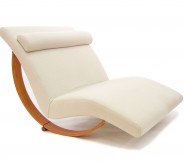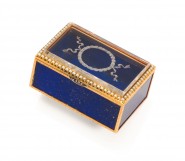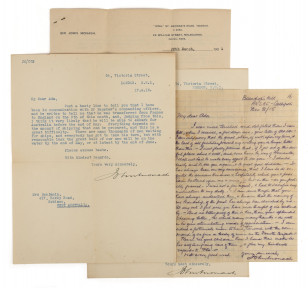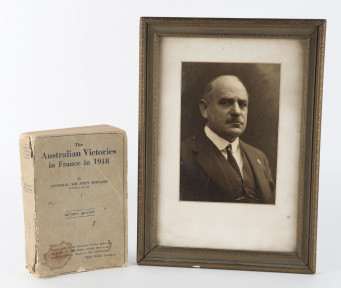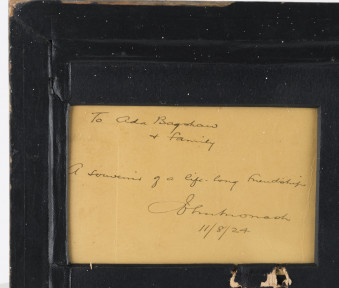Lot #695 - A CORRESPONDENCE OF ELEVEN LETTERS FROM JOHN MONASH TO ADA BENJAMIN (née Krakowski): 1911 to 1926
-
Auction House:Leski Auctions
-
Sale Name:Australian & Historical
-
Sale Date:03 Dec 2022 ~ Session 1 (Lots 1 - 670) 10am (AEDT)
04 Dec 2022 ~ Session 2 (Lots 671 - 1277) 10am (AEDT) -
Lot #:695
-
Lot Description:A CORRESPONDENCE OF ELEVEN LETTERS FROM JOHN MONASH TO ADA BENJAMIN (née Krakowski): 1911 to 1926
During the turbulent and hugely consequential years that included his service during World War One, John Monash [1865 - 1931] maintained a correspondence with his “old flame” Ada Krakowski [1864 - 1937]. Monash had married Hannah Victoria (“Vic”) Moss in 1891 and they had one child, Bertha. Ada Krakowski had married Samuel Benjamin, (whom she had met at the Melbourne Jewish School in the 1870s) and following his death in 1911, Alfred Bagshaw. The following letters, several accompanied by their original envelopes, survived in the hands of Ada’s children until a few years ago and are now available for the first time, more than a century after the correspondence took place. The contents provide several fascinating insights into the life of one of Australia’s most important military men, who also made a significant contribution in civilian life. Letter dated Sept.7, 1911, sent from Melbourne: A hand-written and signed letter of bereavement to Ada on his hearing that her husband, Samuel Benjamin, had passed away. “.....I can never forget the happy days in Perth with you & Sam, whom I deeply esteemed & whose loss will, I feel sure, be mourned by many....”; Letter dated Dec.8, 1915, headed “Beauchop’s Hill, ANZAC - Gallipoli”: A signed letter in Monash’s meticulous hand-writing “...I am indeed a fortunate man to have been honoured with the command of so fine a body of men as the Fourth Brigade....” “...if I get out of this awful place alive & well,...I shall make every effort to see you....”; Letter dated Feby 13, 1918 (with reference to the previous letter) Three-page letter in Monash’s hand, signed “JM”: “...I also heard for the first time that you had safely received my letter written to you from Gallipoli in 1915, and that you had replied to it. Your reply never reached me, so many letters have been lost at sea by enemy action....” “...the affairs of the 20,000 men under my command leave me little leisure or privacy that I cannot write even a page or two without constant interruptions.....life is very strenuous for a Divisional Commander...” “...No doubt you have heard of my having been awarded a Knighthood in the New Year’s honours list. - As I am the first Australian who has won his Knighthood in the field I am naturally very proud of it; but it is all due to the splendid division which I have the honour to command, & which has had many great victories at Messines, Broodseinde, Paaschendale & elsewhere -.”; Letter dated Feb. 20, 1919, sent from 54, Victoria Street, London S.W.1. A typed letter, signed in full: “....your last letter....reached me on November 30th, on the very day when I relinquished the command of the Australian Army Corps, in order to come to London to commence organising the Department of Repatriation which I am now controlling...”; Letter dated Apr.17, 1919, sent from 54, Victoria Street, London S.W.1. A typed letter, signed in full: “....There are many thousands of men waiting for ships, and everybody has got tp take his turn, but with reasonable luck the great bulk of our men will be on the water by the end of May......”; Letter dated Dec.21, 1919, headed “S.S. Ormonde”, At Sea: A typed letter, signed in full: “....just a line in great haste to thanks you and Flo very warmly for coming to the King’s Park to see us for those few exciting moments. It is a great regret that the Minister of Defence monopolised the whole of my time in Perth....”; Letter dated March 28th, 1924, headed “Iona” St. Georg’s Road, Toorak: A two-page typed letter, signed in full: In discussing the changes evident in two photographs sent six years apart, Monash concludes “The two group photographs are now safely reposing in my little collection of photographs of my intimate friends.....The years are dealing lightly with you... “...My only daughter and I live together, with her husband and my little grandson. He is a very fine little chap, now nearly two years of age, and is a source of much pleasure to me...”; Letter dated August 11, 1924, headed “Iona” St. George’s Road, Toorak: A typed letter, fully signed: “...I now have a second little grandson, aged about 6 weeks. Both children are a source of much joy and pleasure to me....” “...As for myself, they work me very hard, and I am much in request for all kinds of public services...” Accompanying this letter was “a recent photograph of myself.”, which is included with this collection. It is signed, dedicated and dated verso; Letter dated Jan.4th, 1926, headed “Iona” St. George’s Road, Toorak: A typed letter, fully signed: “I was very shocked to get Doris’ telegram saying that you had been ill in hospital with typhoid....” Letter dated August 2, 1926, headed “Iona” St. George’s Road, Toorak: A two-page typed letter, fully signed: Writing prior to a forthcoming visit to Perth, Monash writes “...I have not forgotten my disappointment at the few fleeting moments which we had together when I cam back from the war, while I was unveiling the memorial to the Jewish Soldiers. At any rate, I hope that, on this occasion, we should be able to do a little better than that. What do you think?...” By this time, Ada and her family had moved to the remote farming township of Welbungin; Letter dated September 1, 1926, headed “Iona” St. George’s Road, Toorak: A typed letter, fully signed: Back in Melbourne after his visit to Perth, Monash writes “....to say how much I enjoyed seeing so much of you and Flo, and....to send you a copy of my book and a copy of my Presidental Address before the Association...” While in Perth, Monash had handed over the presidency of the Australasian Association for the Advancement of Science. The book, signed and dated, accompanies the letter. -
Notes:General Sir John Monash, GCMG, KCB, VD (1865 – 1931) was a civil engineer and military commander during the First World War. He commanded the 13th Infantry Brigade before the war and then, shortly after its outbreak, became commander of the 4th Brigade in Egypt, with whom he took part in the Gallipoli campaign. In July 1916 he took charge of the newly raised 3rd Division in northwestern France and in May 1918 became commander of the Australian Corps, at the time the largest corps on the Western Front. Monash is considered one of the best Allied generals of the First World War and the most famous commander in Australian history. Among his many honours, Monash University, founded in 1958, was named in his memory. A summary of his official biography: Soldier, Engineer and Administrator. He was born in Dudley Street, West Melbourne, the first of three children of Louis Monash (formerly Monasch of Jewish Prussian origin) and his wife Bertha, née Manasse. He was educated at Scotch College, and at 16 was dux of the school. He graduated from the University of Melbourne: B.A. 1887; master of civil engineering in 1893; in law 1895, and doctor of engineering in 1921. He married Hannah Victoria Moss in 1891 and they had one daughter, Bertha. He worked as a civil engineer, introduced reinforced concrete to Australian engineering practice, was engineer for a bridge over the Yarra River and took a leading part in his profession becoming a president of the Victorian Institute of Engineers, and a member of the Institution of Civil Engineers, London. His involvement in army service spanned 36 years from 1884 (when he joined the university militia unit) until 1920 (in his role in-charge of repatriation of troops after WWI). When war broke out in 1914, he became a full-time army officer despite his German background, and he was sent to Egypt as commander of the 4th Infantry Brigade. His service can be summarised as follows: Gallipoli campaign; Battle of Messines; Battle of Broodseinde; First Battle of Passchendaele; Battle of Hamel; Battle of Amiens; Battle of the Hindenburg Line. His army service could not be classed as smooth, and at one stage the then Prime Minister, Billy Hughes, arrived at the front before the Battle of Hamel prepared to replace Monash, but after consulting the senior officers, and seeing the superb power of planning and execution he displayed, Hughes changed his mind. The official Australian War Historian, Charles Bean was not a fan of Monash’s early military career, but he noted that Monash was more effective the higher he rose in the army, when he had a greater opportunity of utilising his skill for meticulous planning and organising, and to innovate in the area of technology and tactics. On 12 August 1918 he was knighted KCB on the battlefield by King George V. He returned to Australia on 26 December 1919 to a tumultuous welcome and he filled many important positions in his post-army career, including: head of the State Electricity Commission of Victoria; Vice-Chancellor of the University of Melbourne until his death; president of the Rotary Club; one of the principal organisers of the annual ANZAC day commemorations; chairman of the constructing body of the Shrine of Remembrance; and, president of the Australasian Association for the Advancement of Science. In the 1920’s Monash was broadly accepted, as the greatest living Australian. He died at his home “Iona” and there was a State Funeral with crowds of at least 25,000. He was buried in the Jewish Section of Brighton General Cemetery.
-
Estimate:A$10,000 - 15,000
-
Realised Price:
-
Category:Militaria & Weapons
This Sale has been held and this item is no longer available. Details are provided for information purposes only.

